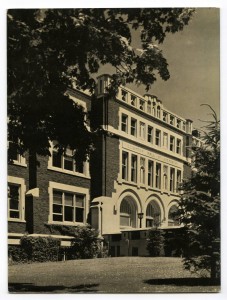This past weekend was my first time working with Carleton’s Gould Library Collection. My work involved searching through existing archival databases and finding images of Leighton Hall. During the process I got chance to learn a lot about metadata, and I am happy to share my experience with you.
I would like to start by explaining what metadata is, for readers who have yet to encounter this notion.
Metadata is structured information that describes, explains, locates or otherwise makes it easier to retrieve, u se, or manage an information resource. In simpler terms, metadata is data about data or information about information.
se, or manage an information resource. In simpler terms, metadata is data about data or information about information.
The most recent DH project that I participate in involves researching campus buildings from historical archives. For my part, I chose to reconstruct Leighton because I love its architecture and the greenery surrounding it.
My exploration of Leighton began with browsing through the Digital Collection of books on Carleton’s history and finding images associated with the building. Among the books that I referred to are Carleton Remembered, 1909-1986 by David H. Porter and Merrill Jarchow, History of Carleton College by Delavan L. Leonard, and many more.
Each time I bump into an image that I want to use, I would carefully record all the information associated with it and sort the data into these categories: title, subject, description, creator, source, publisher, date, contributor, rights, relation, format, language, type, coverage. The process of categorizing metadata was the most time consuming part of my research since there is a lot of information associated with every image that needs to be processed.
Why bother with metadata?
There are several advantages to collecting data this way. First of all, storing metadata is incredibly useful because it makes it possible for other researchers to find relevant sources and information. I was able to collect so many historical images precisely because Carleton Library has all its resources in the Digital Collection documented so carefully. Second, having metadata along with a project ensures that the resources will be preserved. Even if something happens to the original source, the information would still be accessible to future researchers.
The only disadvantage for a researcher who wishes to work with metadata would be the amount of time that needs to be allocated to the process.
I appreciate the way you explained metadata at the beginning. I like how the main point of the post was metadata and your experience of gathering the photos & data from the archives was just the supporting evidence.